
by Timothy Oleson Thursday, December 31, 2015
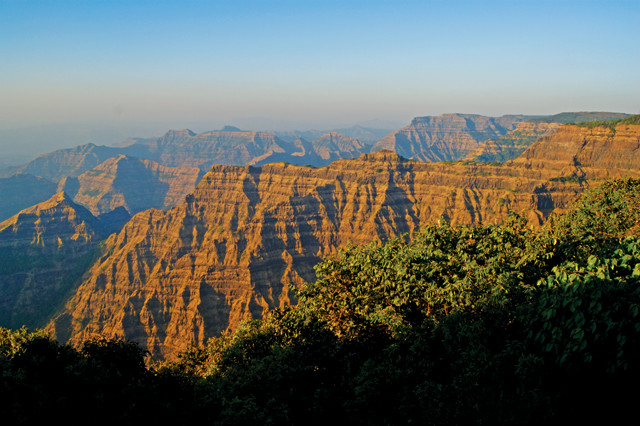
The mountains of basalt that remain hint at the scale of volcanism that heaped massive amounts of lava onto the Indian subcontinent around the time of the Cretaceous-Paleogene transition. Credit: Blair Schoene.
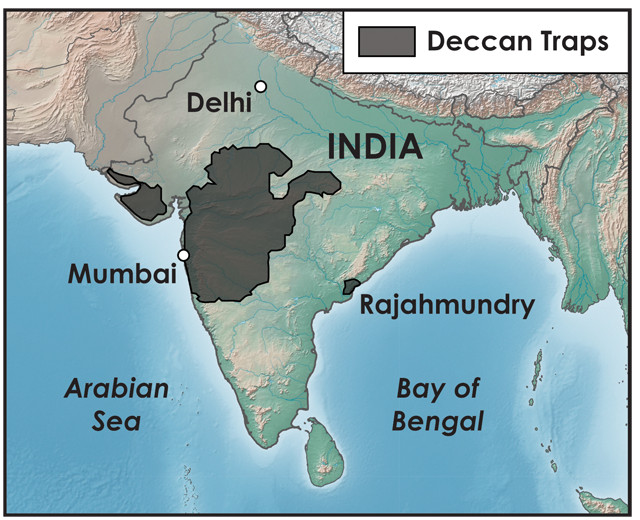
The Deccan Traps sprawl over more than half a million square kilometers of India. Credit: K. Cantner, AGI.
Few episodes in geologic history are as widely recognized as the Cretaceous-Paleogene, or K-Pg, boundary 66 million years ago. Utter “K-Pg,” “K-T” (for Cretaceous-Tertiary, as it’s still commonly known) or “end-Cretaceous” to any geoscientist and you’re virtually assured of a knowing glance as he or she recalls at least the textbook basics of a large bolide impact and mass extinction that finished off the dinosaurs and gave rise to the Age of Mammals. Mention it to science-interested laymen, meanwhile, and they may conjure images of tyrannosaurs peering over their shoulders in anguish as they flee from streaking meteors.
These catastrophic events make for a compelling and, aside from artistic liberties taken in some recountings, mostly truthful tale. Paleontologists have long recognized from the fossil record that more than half of the species inhabiting Earth perished at the end of the Mesozoic — the most emblematic of course being the remaining nonavian dinosaurs, like T. rex and Triceratops. And for the last quarter-century, since the identity and approximate age of the roughly 200-kilometer-wide Chicxulub crater on Mexico’s Yucatán Peninsula were confirmed, the impact’s devastating blast, and resulting fallout, has been the favored explanation for the K-Pg extinctions.
But before the impact’s ascendance in both the scientific and popular psyches, another prevailing hypothesis invoked to explain the mass die-off described an altogether different global calamity: massive volcanism that heaped layer upon layer of basaltic lava onto the Indian subcontinent and belched climate-modifying gases and aerosols into the atmosphere. Possibly totaling more than 1 million cubic kilometers, these lava flows — known as the Deccan Traps — erupted over several million years, beginning before and ending after the mass extinction.
The debate over the cause of the K-Pg extinction has continued to simmer through the years, boiling over at times as proponents of each explanation traded barbs in the literature and at scientific meetings. But as researchers have continued amassing relevant data — geochemical, geochronological, paleomagnetic, paleontological, sedimentary and stratigraphic — explanations for the extinction involving both the impact and volcanism have emerged.
It’s not certain whether a definitive picture of exactly what happened is even possible. However, improvements in rock-dating techniques and in understanding the complex and sprawling stratigraphy of the Deccan Traps and the Chicxulub impact deposits have offered the clearest views yet of the timeline of events. Shoring up this critical part of the story would be a major step, scientists say, in revising our perception of this extraordinary episode in Earth history.
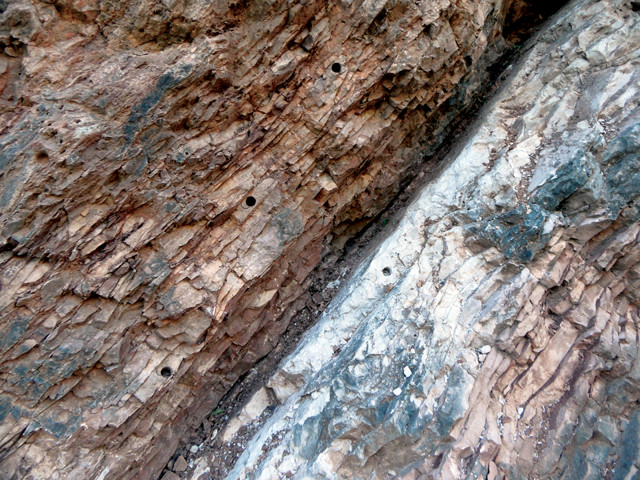
The Cretaceous-Paleogene boundary can be seen at Gubbio, Italy. Here, drillholes are visible from coring in the 1980s. Credit: Terri Cook and Lon Abbott.
Fossil records of marine plankton and terrestrial plants suggest that, in the last million years or so of the Cretaceous, the warm global climate that prevailed through the period was cooling in fits and spurts: Earth experienced a series of brief cold snaps, with average annual temperature swings of 2 to 8 degrees Celsius possibly accompanied by large sea-level fluctuations. These same records, combined with those of mammals from the well-studied Hell Creek Formation in Montana, show that many of Earth’s ecosystems faced on-again, off-again environmental stress, resulting in shifts in biodiversity and loss of species.
The scale of change leading up to the K-Pg boundary pales in comparison, however, to what happened during the main pulse of extinction, when an estimated 60 to 70 percent of Earth’s species died off in a geological instant. In addition to the dinosaurs, many other large land animals and terrestrial plants, as well as marine reptiles, mollusks and numerous ocean-dwelling microorganisms, succumbed. Other evidence from the geologic record also points to a major disturbance on Earth at about the same time as this huge pulse of extinction: A sudden shift in carbon isotopic ratios and a decrease in the amount of calcite observed in marine sediment cores indicate drastic drops in biological productivity and carbonate sedimentation in the oceans — markers traditionally taken to define the K-Pg boundary.
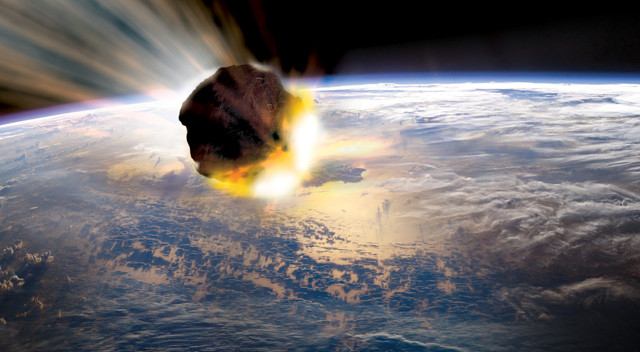
Images like this one of an asteroid hurtling toward Earth are often what come to mind when people think about the Cretaceous-Paleogene mass extinction that ended the Age of the Dinosaurs. Credit: K. Cantner, AGI.
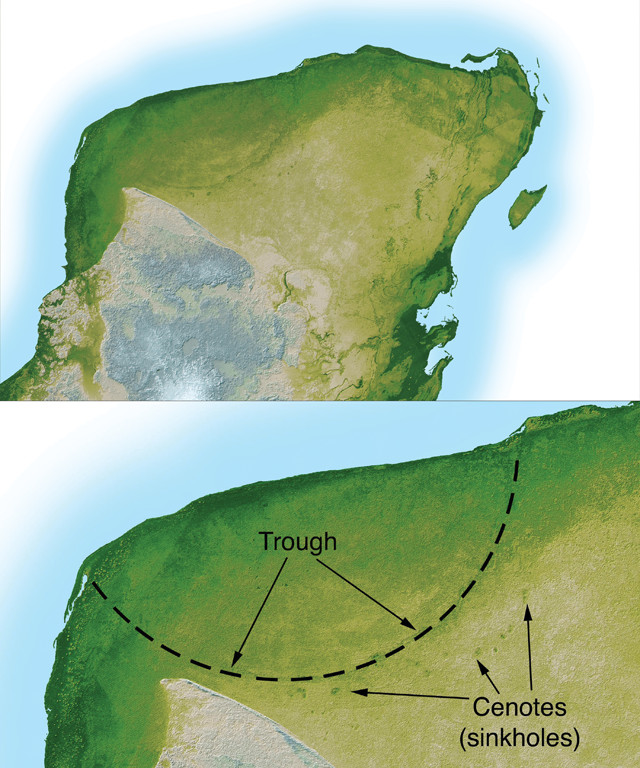
This shaded relief map (and labeled inset) of the Yucatán Peninsula indicates the location of the buried Chicxulub crater. Credit: both: NASA/JPL.
At certain locations on land, layers of sediment enriched in iridium and other rare metals, of shocked quartz and droplet-shaped particles called tektites — which form when melted rock resolidifies quickly as it flies through the air — indicate that something big struck the planet around the same time that the extinctions were occurring. It was these terrestrial deposits, particularly at Gubbio in Italy’s Apennine Mountains, that prompted a group led by University of California at Berkeley physicist Luis Alvarez and his son Walter, a geologist also at UC Berkeley, to lay out the first detailed hypothesis in 1980 that a bolide about 10 kilometers wide had slammed into Earth, sending large amounts of rocky debris and gases into the atmosphere and perhaps sealing the unfortunate fates of so many species.
Eleven years later, researchers announced evidence of a massive crater in the carbonate rock buried beneath Mexico’s Yucatán Peninsula. The position and inferred age of the crater — named after Chicxulub Puerto, the coastal town near its center — matched up with the patterns and timing of fallout observed at Gubbio and a host of other such sites. The Chicxulub crater and its debris quickly became the keystone argument of impact hypothesis proponents.
Despite the popularity of the impact hypothesis, limitations of impact modeling and geologic dating techniques at the time left the door open to uncertainty about Chicxulub’s size and exact timing relative to the extinctions seen in the fossil record. Could it have affected global climate enough on its own to account for the scale of the extinction episode seen at the K-Pg boundary? And was it actually contemporaneous with the major pulse of extinction, or did it happen sometime before or after?
Additionally, no other mass extinction is known to be associated with a major impact. Four out of five extinctions in the last half-billion years, however, are broadly correlated in time with huge inundations of flood basalts. The Siberian Traps erupted about the time of the end-Permian extinction, for example, which is thought to have knocked off about 90 percent of Earth’s species some 252 million years ago. And the basalts of the Central Atlantic Magmatic Province emerged roughly 200 million years ago, about the time of the Triassic-Jurassic extinction. So there would seem to be more of a precedent for a volcanic culprit at the end of the Cretaceous.
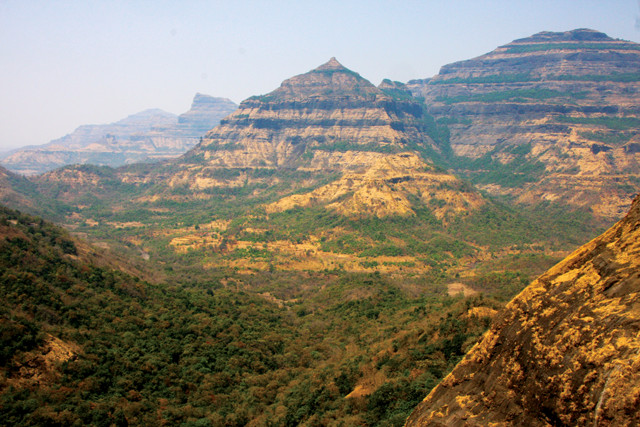
Layer upon layer of Deccan lava is exposed in the Western Ghats mountain range east of Mumbai, India. Credit: Mark Richards, UC Berkeley.
Questions have remained about the impact’s lasting effects, but it at least was a discrete single event that’s relatively well delineated in the sedimentary record (although there has been disagreement over just how clear this delineation is in some locations) and whose size is constrained by the size of the crater it carved. And over the years, repeated studies of impact deposits have led to updated understandings of when the meteorite struck: Ages of 65 million years and then 65.5 million years were once favored, but current consensus puts the impact at about 66 million years ago.
Meanwhile, the complex, tangled pile of Deccan lava flows defies “classical stratigraphic methods,” says Mike Widdowson, a volcanologist at the University of Hull in England. Flows of varying sizes erupted at different places at different times; the basalts look similar to one another to the naked eye; and there aren’t any obvious marker horizons, Widdowson says. These factors complicate efforts to correlate the timing and size of the different flows. It’s also unclear how much lava lies underwater offshore, and how much lava was once on land that has now eroded away.
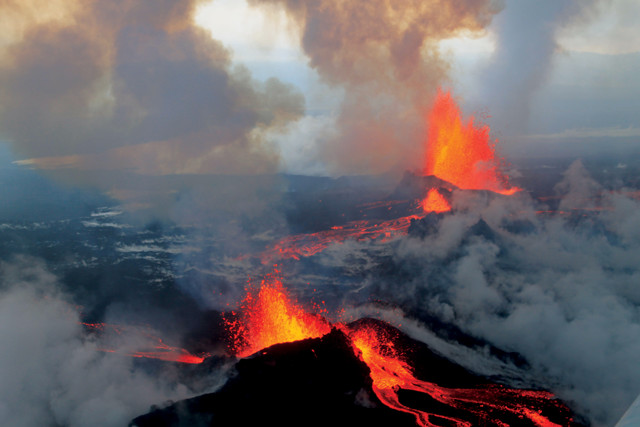
Fresh lava spews from Iceland's Holuhraun lava field in 2014. During Deccan Traps volcanism, the landscape near eruptive vents likely would have looked similar. Credit: Peter Hartree, CC BY-SA 2.0.
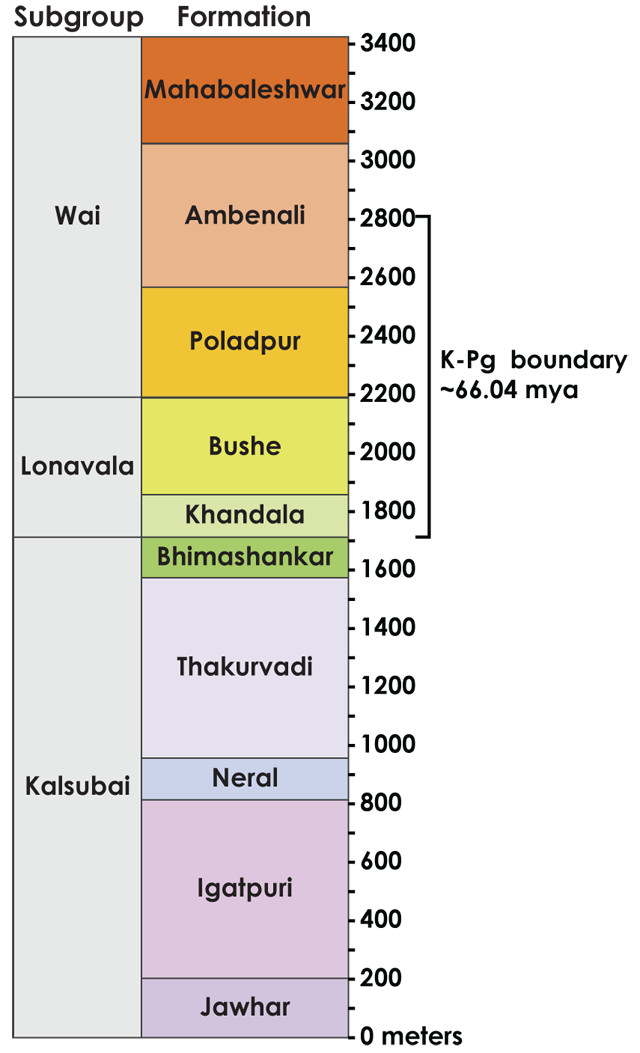
Composite stratigraphic column showing the lava subgroups and formations — which all erupted during the main phase of Deccan volcanism — present in India's Western Ghats mountain range. Formation thicknesses, which vary from location to location, are approximations based on Schoene et al. Science, 2014. The vertical bracket at right indicates where the K-Pg boundary might lie within the stratigraphy based on data from that study and from Renne et al., Science 2015. Credit: K. Cantner, AGI.
Although the traits of the Traps are far less constrained than those of the impact, it is clear that an enormous amount of lava — the Traps sprawl over roughly half a million square kilometers and are still piled more than two kilometers deep in places today — erupted toward the end of the Cretaceous or early in the Paleogene. The sheer volume of sulfur dioxide, carbon dioxide and other gases that vented to the atmosphere would have been staggering — far greater in total than what was kicked up by the impact. Then again, the Traps didn’t erupt all at once, but, rather, in pulses. The major climate-altering gases have limited residence times in the atmosphere — on the order of years for sulfur dioxide to hundreds or thousands of years for carbon dioxide — so the environmental and ecological impacts of Deccan volcanism would have been tied to the size, duration and pacing of individual eruptive episodes. “The most important question right now with regard to the Cretaceous-Paleogene extinction … is exactly what the timing was for these large eruptions in India,” says Mark Richards, a geophysicist at UC Berkeley.
Starting in the 1980s, Widdowson and other researchers began studying the Traps’ geochemistry. “We found that each batch of magma that produced lava flows was unique in that it was fingerprinted in a slightly different way,” he says. “If you look at certain geochemical fingerprints … you can tell where you are in the stratigraphy, and that amazingly holds true for most of the Deccan.” The work allowed scientists to begin mapping the flows, which they classified into distinct, albeit discontinuous, “subgroups” — each of which comprised multiple formations and numerous individual flows — based on their geochemical similarity.
A rough outline of the sequence of different eruptive episodes of the Deccan Traps slowly emerged, but there was still little indication of the actual timing and duration of each episode — crucial factors in establishing potential correlations between the eruptions and extinctions. If much or most of the volcanism occurred soon before the extinctions, for instance, the case could be made for a causal link. If, on the other hand, the volcanism occurred after the main extinction pulse, such a link could be essentially ruled out.
Through the 1990s and 2000s, several groups worked to refine the timeline of the Traps by applying geochronological techniques — particularly potassium-argon and argon-argon dating — to the Deccan lavas. The work combined to suggest that the vast majority of the erupted lava spewed from the ground in less than 1 million years. Additionally, this interval seemed to overlap with the timing of the Chicxulub impact.
In the late 2000s, studies led by Anne-Lise Chenet and Vincent Courtillot of the Institute of Global Geophysics in Paris offered further clarification on the timing and pacing of Deccan volcanism. Through geochronological and paleomagnetic analyses of minerals in the lavas and comparison with an established geomagnetic age timeline, they proposed that the volcanism occurred in discrete phases. A small initial phase dating to about 67.5 million years, well before the main K-Pg extinction, preceded a massive second phase, which Chenet, Courtillot and their colleagues thought had peaked about 65 million years ago. The researchers found that nearly all of the lavas of this phase, which account for about 80 percent of known Deccan lava volume, erupted within a portion of the geomagnetic timeline known as chron C29r — a roughly million-year-long period thought at the time to have ended shortly after 65 million years ago.
As the K-Pg boundary and extinction were thought to date to late in this chron, the team concluded that the large second phase occurred at least partly during the lead-up to the boundary, strengthening the case for a role of volcanic emissions in the extinctions. Further, they found that the lavas of this phase likely erupted in a series of about 30 eruptive events, each lasting only a hundred years or so. These punctuated eruptions could have thus spewed high concentrations of ash and gas into the atmosphere over short periods of time, potentially compounding environmental degradation from the volcanism. “The chemical input of the Chicxulub impact would have been on the same order as that of a very large single [eruptive event],” the researchers wrote in a 2009 study in the Journal of Geophysical Research – Solid Earth, concluding: “The impact, therefore, appears as important but incremental, neither the sole nor the main cause of the Cretaceous-Tertiary mass extinctions.”
Other studies — both prior and since — have countered the group’s notion that there were discrete pulses of Deccan eruptions, however, suggesting instead that relatively low levels of volcanism beginning as early as 69 million years ago likely continued unabated until activity rapidly accelerated closer to the K-Pg boundary.
Still, from the paleomagnetic work of Chenet, Courtillot and their colleagues, “we knew clearly that the main phase of the Deccan Traps was quite short,” beginning “maybe a little bit before the K-T [boundary],” says geologist Thierry Adatte of the University of Lausanne in Switzerland. But the timing still “was not very clear in terms of absolute dating,” he says. Even the best radiometric ages for the lavas and the geomagnetic timeline came with error estimates of several hundred thousand years, confounding efforts to determine whether the largest Deccan eruptions — and their accompanying bursts of climate-altering gases — actually happened shortly before or shortly after the main extinction.
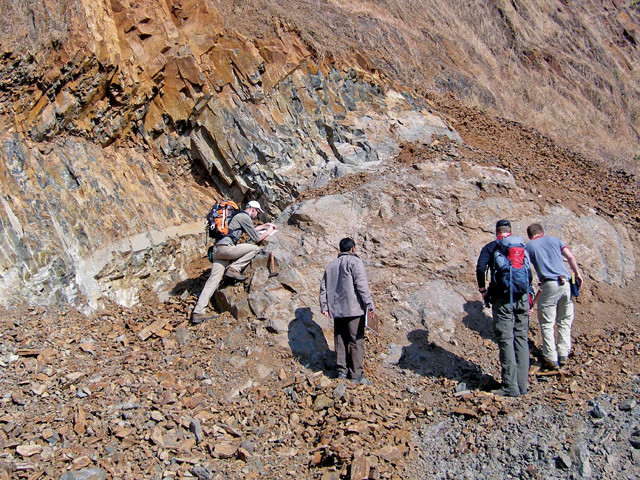
Researchers climb scree-covered slopes in India looking for suitable sites to sample for zircons. Credit: Gerta Keller.
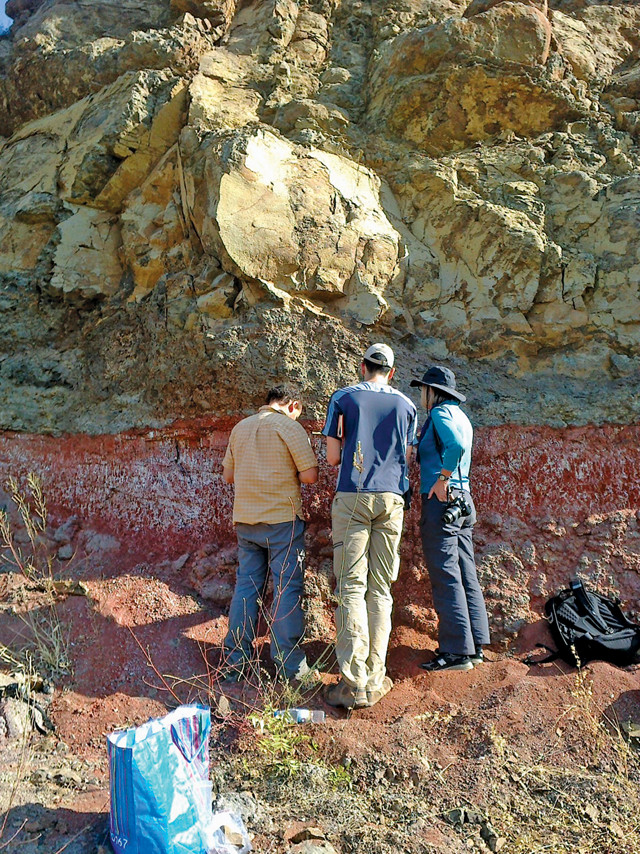
Thierry Adatte (left) and colleagues take a close look at a layer of weathered lava, called a red bole, in the Deccan Trapsddy.
“The existing geochronology was not adequate to answer the questions people were asking” about the eruptions, says Blair Schoene, a geologist at Princeton University. Beginning in 2013, he teamed up with Adatte and others to collect zircon crystals from the Traps to analyze with high-precision uranium-lead dating.
Zircons very rarely form in the basaltic lavas of the Deccan, so the rese in layers called red boles that occur between some of the flows. These layers represent quiescent periods, likely lasting thousands of years or more, between Deccan eruptions, during which natural weathering converted fresh, exposed basalt into soils. As the soils formed, debris — including tiny zircons — from explosive volcanic eruptions elsewhere in the world rained down and mixed into the red boles.
Although previous efforts had failed to locate dateable zircons, Schoene’s team pulled a handful of the crystals from boles situated near the bottom and top of the massive lava stack from the second phase of Deccan volcanism. “We were able to date precisely the onset of what’s considered the main eruptive package of the Deccan,” as well as the end, Schoene says.
The dates, reported in Science in late 2014 and bearing uncertainties of about 30,000 years — instead of 300,000 years or more — showed that this main phase lasted 750,000 years in total and started about 66.3 million years ago. “The most important thing is that it looks like [this phase] started about 250,000 years before the K-T boundary,” Adatte says.
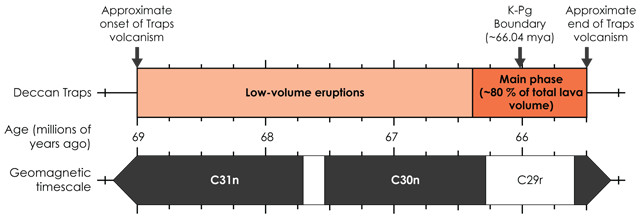
The main phase of Deccan volcanism is thought to have initiated several hundred thousand years prior to the Cretaceous-Paleogene (K-Pg) boundary and continued for about half a million years beyond the boundary. Note that the arrow in this figure only denotes the timing of the boundary, not its physical position within the stratigraphic sequence illustrated on page 30, as Deccan eruption rates varied through time. Earlier, smaller lava flows are thought to have mostly erupted in the northern portion of the Deccan expanse mapped on page 27. Shaded portions of the geomagnetic timescale, such as chron 30n (C30n), denote times when Earth's magnetic field had a "normal" orientation, as it does today; unshaded portions denote times when the field had a "reverse" orientation. Credit: K. Cantner, AGI.
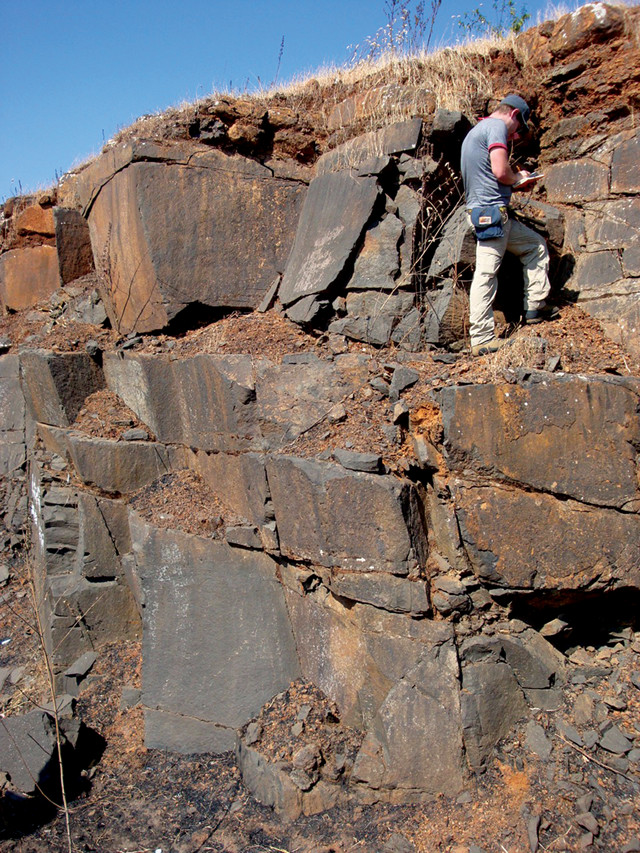
Blair Schoene studies a section of Deccan basalt in India in 2013. Credit: Kyle Samperton.
In parallel with efforts to detail the Deccan eruption timeline, Adatte and colleagues, including Gerta Keller of Princeton, have also been working to understand the varied responses of life in India and elsewhere to the eruptions. Among other sites, they’ve studied sediments found between some of the longest Deccan lava flows — called the Rajahmundry Traps — which stretched up to 1,000 kilometers southeast from the main eruption center in western India to low-lying areas flooded by seawater. In those sediments, deposited during quiet periods between individual eruptions, they’ve found signs of ocean acidification and, based on microfossil remains, evidence that ocean surface-dwelling plankton suffered severe losses. Similar to other locales around the world, including North America and New Zealand, pollen data from India also suggest a shift in terrestrial flora about the same time as plankton were dying off, with trees and flowering plants giving way amid environmental stress to hardier spore-forming fungi.
Overall, Adatte says, “sediments before the K-T boundary show a decreasing diversity in a lot of species,” including not just land plants and plankton but mollusks like ammonites and rudists too — and, of course, dinosaurs. With the new geochronology from the zircon study, “we clearly see that there is a huge coincidence between the maximum activity of the Deccan Traps and the K-T boundary,” he says. “This may explain the decrease in biodiversity that you can see slightly before [the K-T boundary], and it also may explain the main part of the extinction.”
The biostratigraphic data from India confirm that the main K-Pg extinction occurred while Deccan volcanism was ongoing, but gauging the Traps’ possible role in the extinction is still complicated. For one thing, volumes of different Deccan eruptive episodes are still only roughly known, with estimates based mainly on the stratigraphic thicknesses of lava flows in a few well-studied parts of India and on assumptions about the original extents of the flows. Although it’s clear that some formations are larger than others, the volume estimates come with big uncertainties. Yet, those eruptive volumes are “what you really want to know if you want to understand whether the basalts played an important role in the extinction,” Schoene says. If, for example, 90 percent of Deccan lavas were erupted leading up to the boundary, he notes, “that would [suggest] a much different interpretation than if 90 percent erupted after the boundary.” Additionally, he says, with recent improvements in the dating of the impact and extinction from other sites around the world, “where exactly that date sits within the package of basalts is not known yet.”
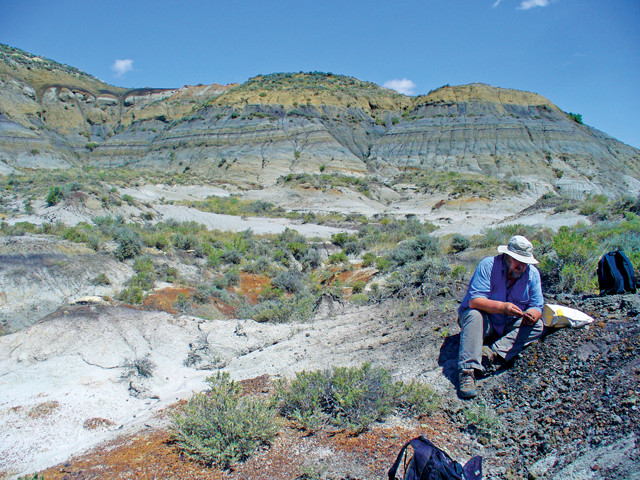
Paul Renne samples volcanic ash from a thin coal bed in the Hell Creek Formation of northeastern Montana. Based on analyses of these and other samples, Renne and his colleagues concluded that the Chicxulub impact and K-Pg mass extinction were synchronous. Credit: Courtney Sprain.
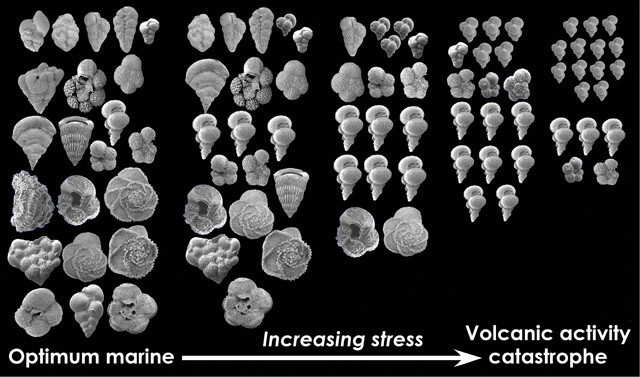
Paleontological analyses of sediments that accumulated between Deccan lava fling quiescent periods in the volcanism have suggested that the diversity of planktic forad progressively, possibly as a result of environmental changes wrought by the volcanism. Credit: Gerta Keller.
The improved resolution of the timing of the Chicxulub impact came in a 2013 study in Science led by Paul Renne of the Berkeley Geochronology Center in California. Using an updated argon-argon dating methodology, he and his colleagues pegged it at 66.04 million years ago, roughly half a million years earlier than the prior estimates. By comparing this date, obtained from analysis of a thin coal layer in Montana’s Hell Creek area — a layer associated with both the Chicxulub iridium anomaly and ecosystem turnover at the K-Pg boundary — with dates obtained for impact tektites found in Haiti, the researchers also concluded that the impact and K-Pg extinction were effectively synchronous. The work showed that both “the main pulse of extinctions and far-field impact signals — like the iridium anomaly, the shocked quartz and other indicators — were in fact related to the Chicxulub structure,” Renne says.
But neither a clear iridium spike nor layers of tektites or shocked quartz have been found in the Deccan Traps. The iridium anomaly is really the “golden spike” that everyone would love to find in the Deccan, Widdowson says. “If you could do that, it would solve a lot of problems because you could then use that as a datum against which we could pin all of these events, and also the changes of biota and extinctions.”
Although an impact-related iridium anomaly in the Deccan might be found in the future, both Renne and Widdowson say it would take a lot of looking and a fair bit of luck. In the meantime, instead of going after the golden spike, researchers are trying to home in on the K-Pg boundary’s position by continuing to fill out the Deccan timeline in more detail.
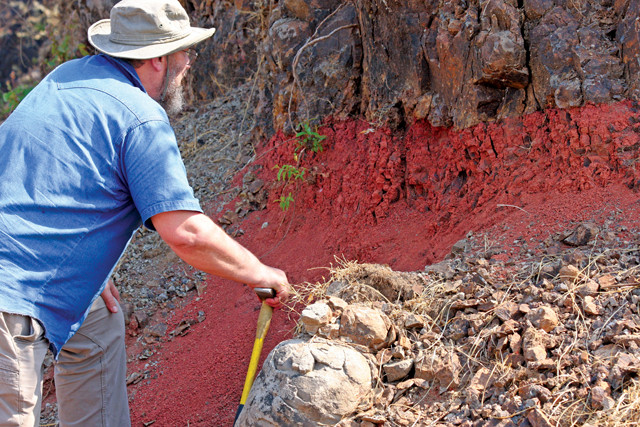
Renne examines a red bole, which formed during a prolonged period of weathering between successive Deccan eruptions. Credit: Mark Richards, UC Berkeley.
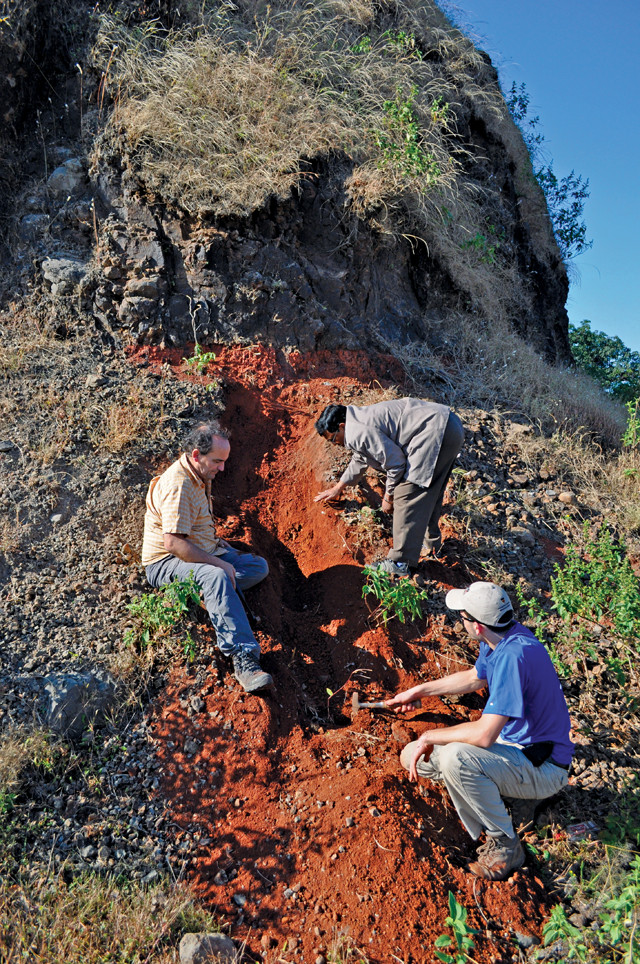
Adatte and fellow team members dig into a hillside in India to expose Deccan sediments. Credit: Gerta Keller.
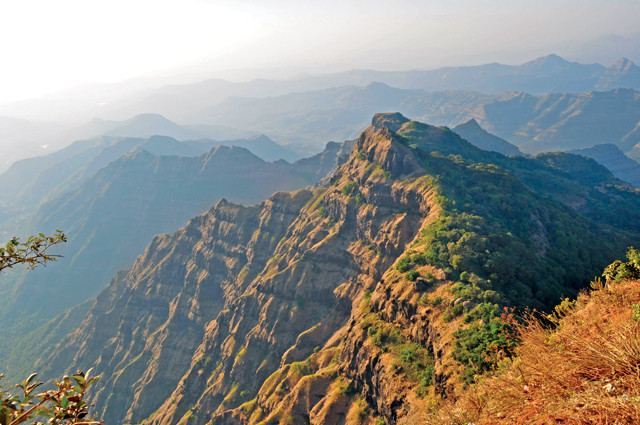
The remaining lava from the Deccan Traps makes for some stunning mountain scenery in parts of India. Credit: Blair Schoene.
The main sequence of Deccan volcanism has long been divided, based on differences in geochemistry, into three subgroups called the Kalsubai (earliest), Lonavala and Wai (latest), each of which is composed of multiple formations and numerous individual flows. The most expansive flows — and some of the thickest — found on the subcontinent compose the Wai subgroup, suggesting it’s the single largest contributor to the Deccan’s total lava volume. In past work, researchers have postulated that the K-Pg boundary lies somewhere in the Wai, citing clues such as the increasing frequency of red boles between lava flows (indicative of a large-scale shift in the pattern of eruptions), or biostratigraphic changes seen, for instance, in the Rajahmundry Traps.
“But only recently have we started to bring in high-precision geochronology tools on the question of the pace and history of volcanism,” Richards says. The zircon study from Schoene’s team was one of the first such efforts. Their dates are the most precise of any published so far, but “they are, for the most part, dates that are well before and well after where we think the actual K-Pg boundary is within the Deccan lavas,” Richards says. “They kind of squeeze things down a little bit, but they still leave several hundred thousand years of uncertainty about exactly what happened in this critical period when we think that the lava flows became much more voluminous.”
In hopes of adding some needed data points to the timeline, Renne, Richards and several colleagues ventured to India in 2014 to collect feldspar crystals from the lavas that they could analyze using the same improved argon-argon technique that produced Renne’s updated age for the impact and the K-Pg boundary. The resulting dates from their samples — pulled mostly from the Kalsubai subgroup as well as one from high up in the Wai — jibe with Schoene’s group’s data, Renne says. And while they still all fall before (for the Kalsubai samples) or after (for the Wai sample) the 66-million-year-old date for the boundary, he says, “we’ve been able to … nail down much more closely where in that [main lava] sequence the K-T boundary would be.”
In a study in Science published in October 2015, Renne and his colleagues reported that the boundary must lie either in the Lonavala subgroup or in the bottom half of the Wai. Interpolation of the data across the remaining gap in the geochronological dataset, combined with their own updated estimates of the lava formation volumes, suggested the boundary may lie at the transition between the two subgroups, and that this transition probably occurred within about 50,000 years after the Chicxulub impact. “It’s looking increasingly probable that that transition was exactly coincident with the K-T boundary and the Chicxulub impact,” Renne says.
If that’s the case, it opens the door to the possibility that the impact might have actually kicked the ongoing volcanism into high gear and implies that the majority of Deccan lavas, composing the voluminous Wai subgroup, weren’t erupted until after the impact and the K-Pg boundary — a hypothesis Richards, Renne and others first laid out in a 2015 study in the Geological Society of America Bulletin. In that study, the researchers noted that large earthquakes are known to trigger volcanic activity at times. Thus, they suggested, the dramatic shifts seen in various geochemical and structural traits of lava flows from one side of the Lonavala-Wai boundary to the other, along with obvious changes in the size, rate and pacing of eruptions, could have been triggered by the impact, which would have jolted the planet with seismic energy possibly equivalent to a magnitude-11 earthquake.
“It’s an interesting idea,” Schoene says. “If it turns out that we see a big pulse of volcanism right at the impact, that’s going to be really fascinating.” But until the geochronology is tighter, he says, “I don’t think … we can really say whether that model is true or not.”
The timing of the boundary in the Deccan Traps “is better constrained than it was,” Renne says, but he agrees that the existing data still leave room for other interpretations. “That’s exactly why we still need to constrain the ages” even more.
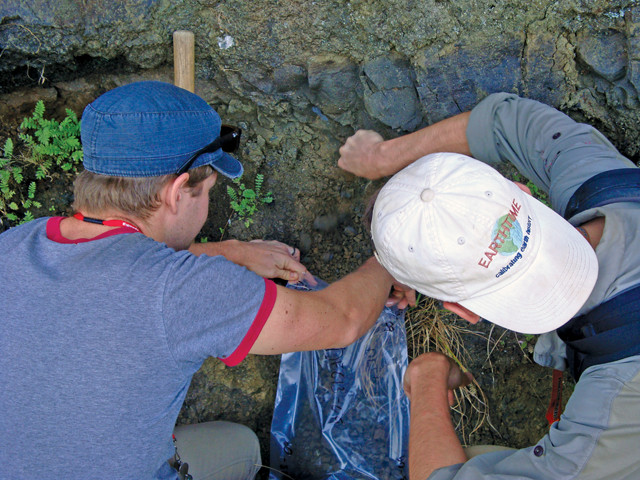
On the hunt for zircons that can be radiometrically dated, Schoene (left) and Mike Eddy of MIT collect material for later analysis. Credit: Kyle Samperton.
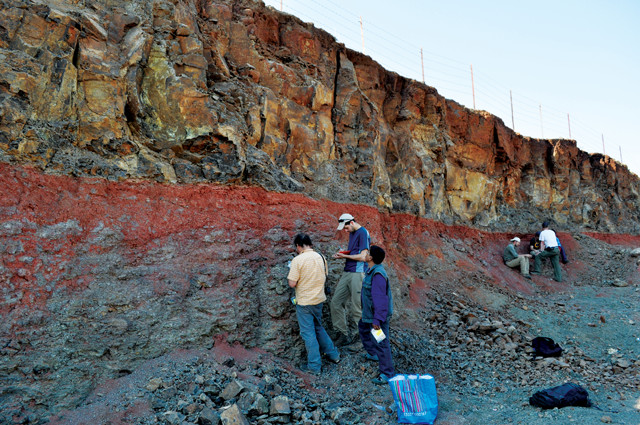
Adatte (far left) and colleagues examine a thick red bole exposed in a quarry. Credit: Gerta Keller.
In addition to continuing to improve the geochronology and volume estimates of the Deccan lavas relative to the K-Pg boundary and the impact, there is plenty of other work left to be done in the effort to understand what happened — and why — during the mass extinction. Fleshing out the global picture of when different plants and animals went extinct with more paleontological data is very important, Schoene says. Additionally, although rough estimates of the amounts of gases and aerosols emitted by both the impact and volcanism have been made, getting a better handle on these emissions for use in paleoclimate models is key. Ultimately, these emissions — and not the impact or eruptions themselves — are the drivers of the complex mix of environmental changes and feedbacks that likely did in so many species.
Regarding the quarter-century debate over whether the Chicxulub impact or Deccan volcanism caused the K-Pg extinction, “as the evidence mounts, it becomes more convincing that both could’ve played a role,” Schoene says. “We know both things happened and that both are potentially devastating,” he says.
It’s an increasingly popular point of view.
“If our results are telling us anything, it’s that we can’t look at the impact and the acceleration of volcanism as individual unrelated things,” Renne says. “They’re closely related in time and their effects probably cannot be totally disentangled.” For example, he notes, it took about 500,000 years after the extinction “for marine communities to begin to recover in a meaningful way,” which is also how long the main phase of Deccan volcanism lasted after the impact. So, it’s possible “that the volcanism, once it was really boosted, suppressed the recovery [of marine life] until it began to wane.”
There is still no unanimity of opinion among scientists studying the K-Pg. But a “growing body” of researchers has taken up a pragmatic middle ground, Widdowson says, acknowledging that both events likely contributed to the extinctions and suppressed the recovery of life to some extent. Whether the blame can actually be parsed between the two events — “50-50, 80-20 or whatever” — is difficult to say, he says.
“I think everyone is trying their best to understand what is perhaps a more interesting scenario than any of us had imagined,” Richards says. “Nature seems to have thrown a real curveball at us on this one, and it has taken a long time to get close to figuring it out. So it’s pretty exciting.”
© 2008-2021. All rights reserved. Any copying, redistribution or retransmission of any of the contents of this service without the expressed written permission of the American Geosciences Institute is expressly prohibited. Click here for all copyright requests.